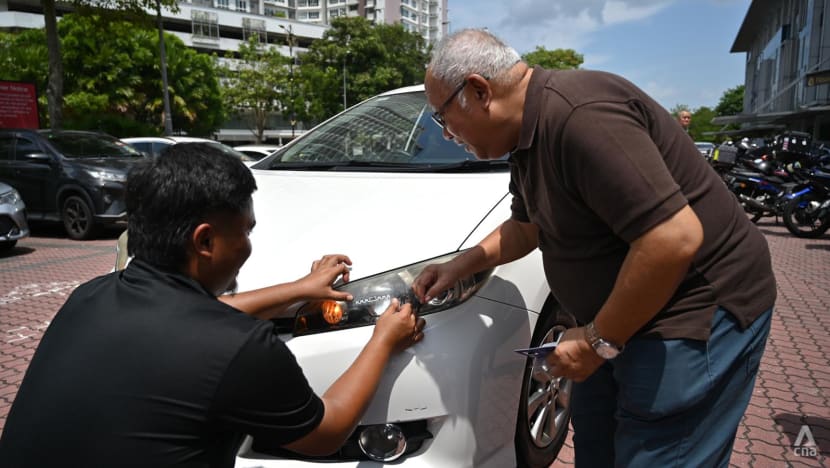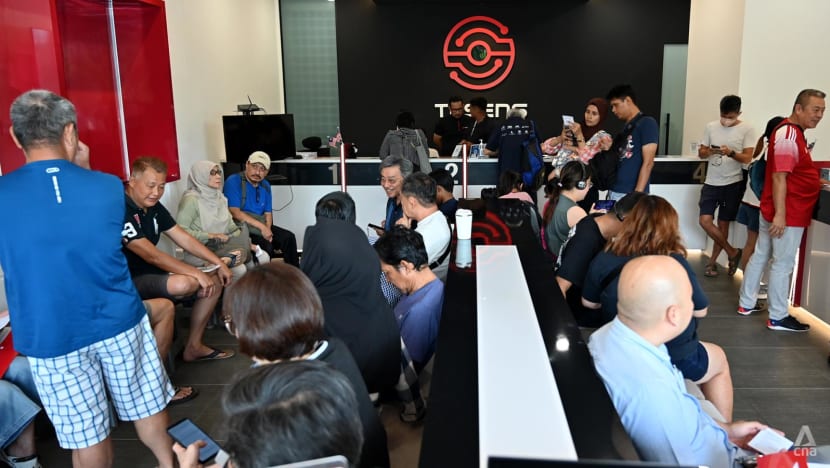As Malaysia’s VEP policy kicks in, what can Singapore drivers expect?
Malaysia will start implementing its Vehicle Entry Permit (VEP) policy on Tuesday. CNA unpacks what VEP is about as well as what Singapore drivers can expect.

A technician tests a Vehicle Entry Permit RFID tag frequency before sticking it on a Singapore-registered car's windshield. (Photo: CNA/Zamzahuri Abas)

This audio is generated by an AI tool.
SINGAPORE/JOHOR BAHRU: The implementation of Malaysia’s Vehicle Entry Permit (VEP) policy requirements for Singapore cars kick in from Tuesday (Oct 1).
Here is what Singapore drivers can expect when they drive into Malaysia:
Those without VEP can still enter Malaysia
The Malaysia government had previously said that the VEP would be enforced on Oct 1, and that motorists who fail to install VEP may be fined up to RM2,000 (US$484) or jailed for up to six months.
But on Sep 27, Malaysia announced that foreign-registered vehicles which have yet to install VEP tags will still be allowed to enter the country.
JPJ said that the enforcement will be "executed in phases" and that drivers with no VEP will be issued a reminder at the land borders to register, install and activate their radio frequency identification (RFID) tags.

JPJ added that drivers will receive a warning notice before they leave Malaysia if they have still not installed their VEP.
However, the statement did not mention if drivers already issued with a warning notice could re-enter Johor without a VEP.
Malaysia has also not confirmed when they will eventually fully enforce VEP requirements, so drivers who have not completed the process are recommended to do so as soon as possible.
Those with VEP can pay toll using RFID tags
Drivers who have already completed the VEP application process can check that their RFID tags are activated.
This can be verified at their TouchNGo e-wallet accounts, under the “VEP JPJ” or “RFID” option in the transport tab of their accounts in the mobile application.
Once it is activated and the e-wallet has been topped up, drivers can pay road charge and toll via their RFID tags at the RFID lane at toll booths instead of physically tapping with their TouchNGo cards.

The RFID sensor at these booths would detect the tags and automatically deduct the amount required, and the barrier gate would then open.
Will VEP be used to monitor if drivers have paid traffic fines?
The VEP system can also be used by Malaysian authorities to track foreign-registered cars who have not paid fines for traffic offences.
In a statement issued in August, JPJ said that while no action has been taken so far, Singapore motorists with outstanding traffic fines in Malaysia will face enforcement action from Jan 1, 2025.
From next year, drivers with unpaid fines may be denied entry to Malaysia and in extreme cases, their vehicles may be impounded by Malaysian authorities.
How to apply for VEP?
For Singapore drivers who have not applied for a VEP yet and wish to drive into Malaysia, they can register for an account at the official website: vep.jpj.gov.my.
Owners of all categories of cars – including private and commercial ones – are required to register for a VEP before entering Malaysia. Embassy and government vehicles are also required to register.
Once the account is authenticated, applicants can log into a portal to upload a vehicle log card or manually fill in information, including the vehicle’s model, certificate of entitlement (COE) and chassis numbers.
The vehicle log card can be retrieved from the Land Transport Authority’s OneMotoring website.
A representative can apply for a VEP on the driver’s behalf.
Drivers can opt to receive the RFID tags by post but many prefer to have them installed at authorised centres, resulting in long queues.
What documents are needed for the VEP application?
All VEP applicants should have their NRIC, passport, vehicle road tax, insurance, car model and COE details ready.
Once an application is approved, what can drivers do?
Once the application is approved, drivers will receive an email notification to choose a method of collecting the VEP RFID tag – either couriered by post to your address, or self-collection at one of the four VEP collection centres.
The RFID tag can be attached either to the top left corner of the windscreen or the left headlamp of the car.

Once attached, drivers should snap a photo of the tag with your car registration number in the frame and upload the image on the VEP portal.

Can drivers seek help at the VEP centres?
There are four VEP centres in total - three are in Johor Bahru while one is in Woodlands. All four centres assist drivers with RFID tag installation but these are done by appointment only.
Two centres - at Danga Bay in Johor Bahru and Woodlands in Singapore - allow drivers to make enquiries.
Officials at both these centres have told CNA previously that they have been overwhelmed by huge numbers of visitors each day. Drivers at Danga Bay are allowed to make walk-in enquiries but in Woodlands, drivers are required to book an appointment for enquiries.

The two other newer centres - one in Taman Daya and the other in Larkin - commenced operations on Sep 23.
The complexes, managed by JPJ officers, boosted Malaysia’s capacity to process the installation of RFID tags by five times to around 1,500 a day.

Why is the VEP implemented now?
The VEP was first announced in 2017.
Malaysian authorities said then that the purpose of the VEP was to tackle car theft and cloning syndicates, and prevent vehicles from leaving the country without paying fines for traffic offences.
Full enforcement was initially set for 2019 but it was delayed multiple times due to technical issues with the portal and poor implementation at the land checkpoints during a pilot project which resulted in congestion.

In May, Malaysian Transport Minister Anthony Loke announced that all foreign-registered vehicles entering the country by land from Singapore would be required to use VEPs from Oct 1.
In June, Mr Loke reiterated that there will be no u-turn on the deadline and Malaysia will not be backtracking on its implementation.
Related:
If you would like to send in information, photos or videos about something newsworthy, submit your news tips on CNA Eyewitness or on WhatsApp.


















